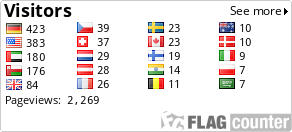"Today Khasab is a picture of calm and tranquility. Situated at the base of the Al Hajar Mountains where the waves from the Strait of Homuz lap gently onto the shore – you couldn’t ask for a more beautiful and peaceful setting. However, the area has not always been like this. Lying astride one of the most important geological features in the Arabia Gulf, the rocks and cliffs forming the dramatic landscape around the bay reveal a history that goes back millions of years and show there were times when the Earth beneath your feet was quite restless."
Ref: Sarah Arkley & Richard Ellison. Visit to Zighy Bay British Geological Survey.
 Photo care of "http://asterweb.jpl.nasa.gov/gallery"
Photo care of "http://asterweb.jpl.nasa.gov/gallery"
.
A closer look at these rocks reveals, preserved in the form of fossil shells, coral, and burrows, the evidence of life that once existed in these long-vanished seas. Today these fossils can be found from sea-level to as high as 2,000m in the Al Hajar mountains, evidence of great tectonic forces that have uplifted these rocks.
The inlets and islands making up the intricate eastern coast of the Musandam Peninsula today are a result of more recent Earth movements. The whole area is very slowly sinking (a few millimetres each year) and the effect of this is to create a drowned landscape; valleys have been flooded by the sea and today form the network of narrow inlets and passageways you can visit by boat or see from the air.
Ref: Sarah Arkley & Richard Ellison. Visit to Zighy Bay British Geological Survey.


By dating the fossils found in these marine sediments, geologists believe that the environment remained constant for approximately 160 million years. Then, some 90 million years ago, the arrangement of the Earth’s plates surrounding Arabia started changing. As two of these plates came together, convulsions and earthquakes affected the whole of the UAE and Oman.

So why is understanding the geology of the area important?
With a sound knowledge of the rocks and structures which make up the foundations of our landscapes, and with a clearer understanding of the role that it plays within the wider environment we can, protect areas which display excellent examples of Arabian geology or are unique features not seen elsewhere in the world, so that future generations may visit, understand and be inspired by them too.
Ref: Sarah Arkley & Richard Ellison. Visit to Zighy Bay British Geological Survey.
To log this cache please email the cache owner the answers to the following questions, do not post in your log.
Questions: 1) Estimate the thickness of the fossil bed then in comparison compare it to the upper and lower boundary layers where the fossils are clearly viable. What can you deduce from this ?
2) Take your time and examine this fossil bed. Describe in you own words what you see?
3)Where are the most complete fossils of shells visible?
4)(Optional) Take a photo at the GZ and add to your log. This can be of fossils you have found at the GZ
The above information was compiled from the following sources:
1. ASTER. (2009). Musandam Peninsula, Oman. NASA Jet Propulsion Laboratory. Accessed April 14, 2009.
2. Sarah Arkley & Richard Ellison. Visit to Zighy Bay British Geological Survey.
3. Schreurs, J. (2007, April 27). Geology of Oman 2007. Accessed April 14, 2009.
4. Geological Overview (pages 40 -62) http://www.uaeinteract.com/uaeint_misc/teanh/005over.pdf
5. All photographs of the fossils taken by Geocachers Avanclan
